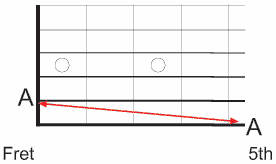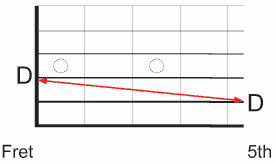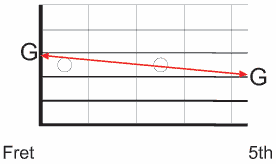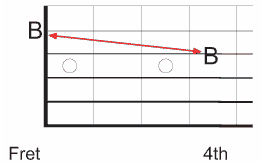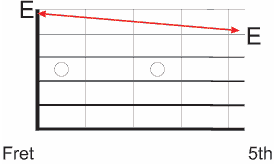|
This is probably the most important piece of knowledge that you can learn when it comes to tuning your guitar. The process of tuning your guitar to itself is one by which you tune each string to another string on the guitar. Basically, it means that you can tune the guitar without having to use a tuner or pitch tool. The only set back about using this method is that your guitar may not end up in exact concert pitch. What I mean by that is that the strings may not run E, A, D, G, B, E as they would if they were in correct concert pitch (you would need a tuner or pitch tool to do that), rather they will all be tuned to whatever note the top string happens to be at the time of tuning. The first step is to get your fifth string in tune with your sixth string. Place a finger on your left hand on the fifth fret of the sixth string. The note that you are holding down is the pitch that string five should be tuned to. Keep your finger in position and pluck the sixth string and let that note ring. As you let the sixth string ring, pluck the fifth string. If the fifth string sounds exactly like the note you are holding on the sixth string, it is in tune. If it is higher, you need to tune down below the note on the sixth string and then bring it back up to match with the fifth fret note on the sixth string. If the fifth string note is lower, you need to tighten the string and bring its pitch up to the fifth fret note on the sixth string. It may take you a while to match pitches exactly but the more practice you get at this, the faster you will be able to do it.
The second step is to get your forth string in tune with your fifth string. Place a finger on your left hand on the fifth fret of the fifth string. The note that you are holding down is the pitch that string four should be tuned to. Keep your finger in position and pluck the fifth string and let that note ring. As you let the fifth string ring, pluck the forth string. If the forth string sounds exactly like the note you are holding on the fifth string, it is in tune. If it is higher, you need to tune down below the note on the fifth string and then bring it back up to match with the fifth fret note on the fifth string. If the forth string note is lower, you need to tighten the string and bring its pitch up to the fifth fret note on the fifth string. Keep tuning the string until you get an exact match for pitch.
The third step is to get your third string in tune with your forth string. Place a finger on your left hand on the fifth fret of the forth string. The note that you are holding down is the pitch that string three should be tuned to. Keep your finger in position and pluck the forth string and let that note ring. As you let the forth string ring, pluck the third string. If the third string sounds exactly like the note you are holding on the forth string, it is in tune. If it is higher, you need to tune down below the note on the forth string and then bring it back up to match with the fifth fret note on the forth string. If the third string note is lower, you need to tighten the string and bring its pitch up to the fifth fret note on the forth string. Keep tuning the string until you get an exact match for pitch.
The forth step is to get your second string in tune with your third string. Place a finger on your left hand on the forth fret of the third string. The note that you are holding down is the pitch that string two should be tuned to. Keep your finger in position and pluck the third string and let that note ring. As you let the third string ring, pluck the second string. If the second string sounds exactly like the note you are holding on the third string, it is in tune. If it is higher, you need to tune down below the note on the third string and then bring it back up to match with the forth fret note on the third string. If the second string note is lower, you need to tighten the string and bring its pitch up to the forth fret note on the third string. Keep tuning the string until you get an exact match for pitch.
The last step is to get your first string in tune with your second string. Place a finger on your left hand on the fifth fret of the second string. The note that you are holding down is the pitch that string one should be tuned to. Keep your finger in position and pluck the second string and let that note ring. As you let the second string ring, pluck the first string. If the first string sounds exactly like the note you are holding on the second string, it is in tune. If it is higher, you need to tune down below the note on the second string and then bring it back up to match with the fifth fret note on the second string. If the first string note is lower, you need to tighten the string and bring its pitch up to the fifth fret note on the second string. Keep tuning the string until you get an exact match for pitch and you will have tuned the guitar to its own strings.
You have just tuned your guitar to itself. If the guitar sounds a little out, you should go back and repeat the process – it is a little hard to master for a start but you should stick to it as it is a very useful skill to have.
|
